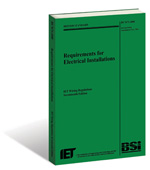George Murphy has written a series of short articles for the Electrical Times magazine that appear as a monthly diary.
These are to keep readers up to date with the changes included in the Amendment 1 of 17th Edition regulations. In case you missed them in Electrical Times or would like to refer to them at a later date, we are reprinting them all here.
From Eectrical Times - May 2011 >>
Wiring regs history, what to expect from Amendment 1
From Eectrical Times - June 2011 >>
European harmonisation - Specific numbering system for the UK
From Eectrical Times - July 2011 >>
Protection for Safety
From Electrical Times - May 2011
In July of this year the first amendment to 17th Edition Wiring Regulations, BS 7671, is due to be published. Over the next few months we will be looking at what this means for electrical designers and installers. In this first instalment, we will summarise the key points they need to be aware of.
First, a bit of history. The Wiring Regulations were first published by the IET (formerly the IEE) in 1980, known as the 15th Edition. This was a complete re-write from previous editions and, after several amendments, the 16th Edition was introduced in 1990. The 17th Edition made its first appear ance in 2008, and the first amendment is due to come into force on the 1st January 2012.
ance in 2008, and the first amendment is due to come into force on the 1st January 2012.
The first important thing to be aware of is that at this stage there are a number of PROPOSED changes; these are not yet finalised. However, it seems fairly certain that the majority of the proposed changes will make it through to the final edition. So it will be very important for anyone involved in electrical design, installation or test & inspection to be aware of the change and how these will impact on their work.
Help in understanding the implications of these changes will come from several directions, not least publications like Electrical Times. In parallel, we will be upgrading our software to reflect the changes and will be holding seminars and other training courses. Many of these changes will be discussed on this page between now and the end of the year.
One thing to be aware of is that the standards laid down in BS 7671:2008 and its amendments are regarded by the Health and Safety Executive as likely to achieve conformity with the relevant parts of the statutory Electricity at Work Regulations 1989. The Wiring Regulations themselves are non-statutory; however they may be used in a court of law to prove compliance or non-compliance with a statutory document.
In addition, when writing the Regulations, the IET has to try to anticipate the day-to-day changes in the industry, such as new cable types, wiring systems and different types of installation. So they have to be written very carefully to ensure they cannot be misinterpreted in the light of these changes.
As a result of all of these considerations, the Regulations themselves can be quite complex – and that’s why the IET also publishes Guidance Notes and an On Site Guide, and these have been laid out in logical manner to make them easy to follow. For example, Part 1 deals with which installations are covered by the Regulations, with subsequent parts dealing with various aspects of design, installation and verification.
So, looking ahead to the coming months, we will be trying to simplify the changes and explain what they mean in practice. For example, in the design it will be necessary to take account of new installation methods, cable de-rating factors and minimum cable sizes. It is also proposed that the requirements for surge protection devices and measures against electromagnetic disturbance will change.
In terms of inspection, it is almost certain that the Periodic Inspection Report will be replaced by a new report, the Electrical Installation Condition Report. So, again, there will be key changes to get to grips with.
Back to top of page >>
From Electrical Times - June 2011
CENELEC (Committee European Normalisation Electro-technique) is responsible for the European standardization in the area of electrical engineering. Any changes to these standards that affect Great Britain must be reflected in our regulations. These changes are usually in the form of Harmonized Documents (HD). The requirements of BS 7671 are founded on the requirements of a set of documents identified as HD 60364.
 The joint committee for low voltage installations is identified as JPEL/64 (Joint committee for Power Electrical.) The 64 denotes the International Electro-Technical Commissions committee for low voltages designation
The joint committee for low voltage installations is identified as JPEL/64 (Joint committee for Power Electrical.) The 64 denotes the International Electro-Technical Commissions committee for low voltages designation
Regulations that are specific to Great Britain will be identified by a new “100” numbering system. For instance regulation 522.6.5 which deals with cables installed under floors or above a ceiling etc will now become Regulation 522.6.100.
This new numbering system is used throughout the Standard and identifies regulations that only apply to Great Britain.
The structure of the BS 7671 has not altered but an additional Appendix has been introduced whilst two have been deleted.
- Part 1 – The Scope has been modified introducing two new special locations namely medical locations and operating or maintenance gangways. These will be discussed in more detail in later diary entries.
- Part 2 – Definitions – this section has increased primarily due to the introduction of the two special locations.
- Part 3 – Assessment of General Characteristics - where Regulations regarding the design of electrical installations commence. No significant changes except for the inclusion of Conductor Arrangement (single phase 2-wire and three phase 4-wire etc) and earthing systems (TN-S, TN-C-S and TT) which have been removed from Part 2 Definitions
From Electrical Times - July 2011
Previously we have looked at BS 7671 Parts 1, 2 and 3 and in this article we will be looking at Part 4 - Protection for Safety. This is arguably the most important part of the regulations as it covers the requirements for protection against electrical shock, thermal effects, over currents, voltage disturbances and electromagnetic interference as a result of magnetic disturbances.
Regarding the requirements of protection against electrical shock, two apparently new types of protective device will appear in Amendment 1.
As of March 2010 BS 88-2-2 and BS 88-2-6 devices have been replaced by BS 88-2 devices. BS 1361 has been withdrawn as a British Standard and the protective devices previously known as BS 1361 will now be re-designated as BS 88-3.
As a direct result, new protective device ratings (16A and 32A etc.) and maximum earth fault loop impedances have been introduced with protective devices, with ratings such as 15A and 30A being deleted.
A new section 444 has been introduced, which states that the designer of the installation must be aware of, and consider, the requirements for the reduction of electromagnetic interference on electrical equipment. Section 444 is a very comprehensive section and it will play a significant part in the design of all new installations.
Electromagnetic interference may disturb or damage equipment. To assist the designer, this section describes methods to avoid electromagnetic disturbances in detail and provides recommendations to reduce the effects of these disturbances where necessary.
These methods include the use of bypass equipotential conductors to reinforce the screening and the use of surge protective devices and/or filters to limit transient over voltages and divert damaging surge current away from sensitive equipment. Also included are the common routing of live and protective conductors of individual power circuits, thus avoiding inductive loops and the segregation of power and signalling circuits from each other.
Over the years there has been a dramatic increase in the installation of Information Technology (IT) equipment and standard electronic equipment that may be susceptible to this interference. Precautions should therefore be taken during the design, erection and verification stages to ensure that the electromagnetic interference caused by the switching of inductive loads, welding machines, x ray machines, rectifiers, lifts, transformers, large motors and circuits containing banks of fluorescent lighting etc is kept to a minimum.
The designer must determine whether there is a danger that cables carrying significantly large currents may induce excessively high voltages into adjacent cables when switched on or off, as these may in turn supply information technology systems - thereby causing either loss of information or damage to the installed equipment.
He or she must then ensure that the installer is aware of the necessity and the adequacy of the segregation or separation methods applied to these cables.
Consideration should also be given to installations within or near to medical rooms as magnetic fields can have serious adverse affects on medical equipment, the consequences of which may be extremely serious.
The person in charge of the verification process now has a more significant role than ever. As always, he or she must be fully conversant with the requirements and must ensure that they have been applied during the design and erection process.
The whole section is new and comprehensive and it is the designer’s signature on the certificate which specifically states that the installation is in compliance with the requirements of BS 7671:2008 Amendment 1.
Back to top of page >>

